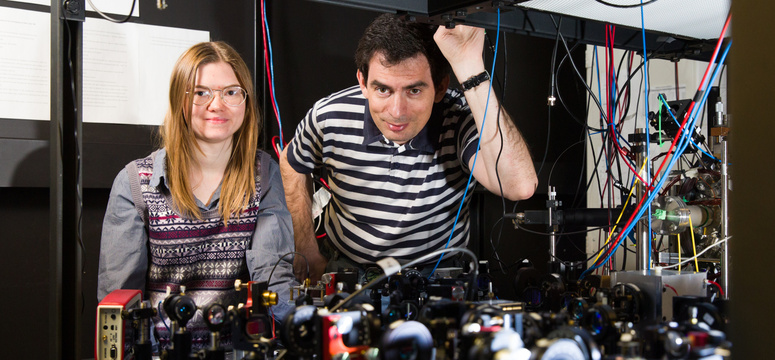A Canadian-Russian team of quantum physicists led by the University of Calgary has found a way to "breed" Schrödinger’s cats that grow ever larger and more energetic.
These strange felines are literally a world removed from your household tabby cat.
The team, led by Alexander Lvovsky, professor in the Department of Physics and Astronomy in the Faculty of Science, developed a quantum method to repeatedly breed “optical Schrödinger’s cat states.” Their experiment , conducted at the Russian Quantum Centre in Moscow, didn’t involve actual cats, but two opposite and simultaneously existing states of light in what quantum researchers call a “superposition.”
“We need to construct bigger and bigger superposition states and test to see if they preserve their quantum properties,” says Lvovsky, who is also head of the quantum optics laboratory at the Moscow centre. “This gives us a tool to probe where the boundary is between classical physics and the quantum world, which is one of the fundamental questions of physics.”
Quantum physicists first created a Schrödinger’s cat in 2006, but the team’s experiment is the first to make the cats increasingly bigger and having greater energy. Their study, “Enlargement of optical Schrödinger’s cat states,” is published in Nature Photonics, one of the top-ranked Nature series of journals.
Exploring the world of the very small
The strangeness of quantum mechanics, a world of the very small, allows a microscopic entity to be in two states at once. Quantum scientists theorize that this phenomenon may also extend to larger, macroscopic scales — the world observable to the naked eye.
To explore this idea, physicist Erwin Schrödinger in 1935 proposed a thought experiment. A hypothetical cat is put in a locked box with a vial of poison gas and a piece of radioactive metal. As the metal decays over time, it emits an alpha particle which triggers a hammer that smashes the vial and releases the gas — poisoning Schrödinger’s cat.
The rules of quantum mechanics say it’s impossible to know whether the radioactive particle has been released — and the cat is dead — unless the particle interacts with the environment so that an observer can measure it. Until that happens, the particle can be thought of as being emitted and not emitted at the same time. So the cat is both dead and alive — a paradoxical state called quantum superposition.
Schrödinger’s thought experiment remains a touchstone for modern interpretations of quantum mechanics.
“The development of quantum technologies makes it possible to create increasingly complex quantum states, and Schrödinger’s thought experiment no longer seems too far out of reach,” Lvovsky says.
How the team bred its cats
The team simultaneously put two Schrödinger’s cats onto a beam splitter, a semi-transparent mirror that partly reflects and partly transmits both light waves.
“In essence, we cause interference of two cats on the beam splitter,” says paper co-author Anastasia Pushkina, for whom the experiment formed her master’s degree at the Moscow centre.
The entanglement of the two cats leads to a superposition state in the beam splitter’s two output channels, including one channel with a special detector.
“In the event this detector shows a certain result, a ‘cat’ is born in the second output whose energy is more than twice that of the initial one,” explains Pushkina, who is now pursuing her PhD at the University of Calgary.
Another team member and co-author, UCalgary undergraduate student Matthew Richards, spent a summer at the Moscow centre acquiring data from the experiment.
The team, which also included three Russian PhD students, generated several thousand Schrödinger’s cats in which the light’s energy increased from an average 1.3 photons to 3.4 photons. Demid Sychev, a graduate student at the Russian Quantum Center and lead author of the paper, says the team’s method can be repeated and new cats produced with even higher energy levels.
This will help scientists understand whether the quantum world has a limit, and also can be useful in quantum communications and quantum computing technologies, which involve manipulating complex entangled quantum systems, Sychev says.
The work was supported by the Natural Sciences and Engineering Council of Canada and by the Canadian Institute of Advanced Research.








